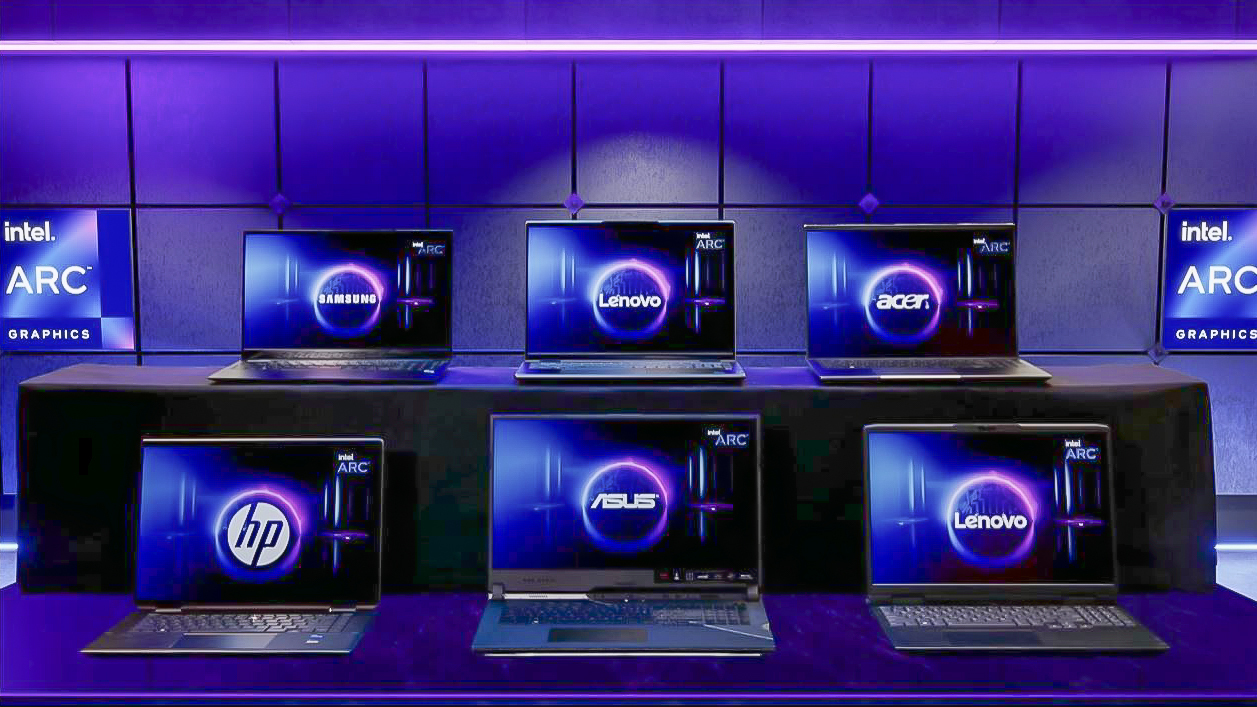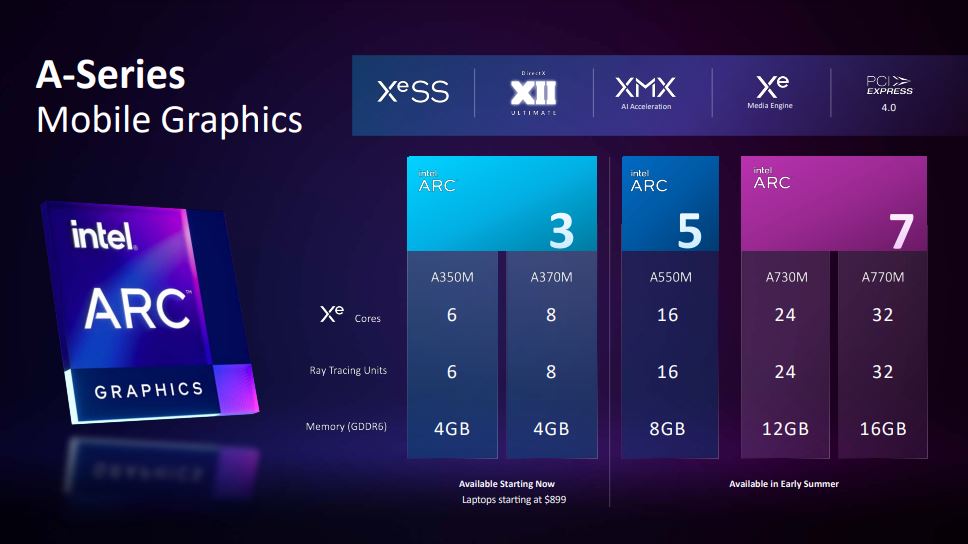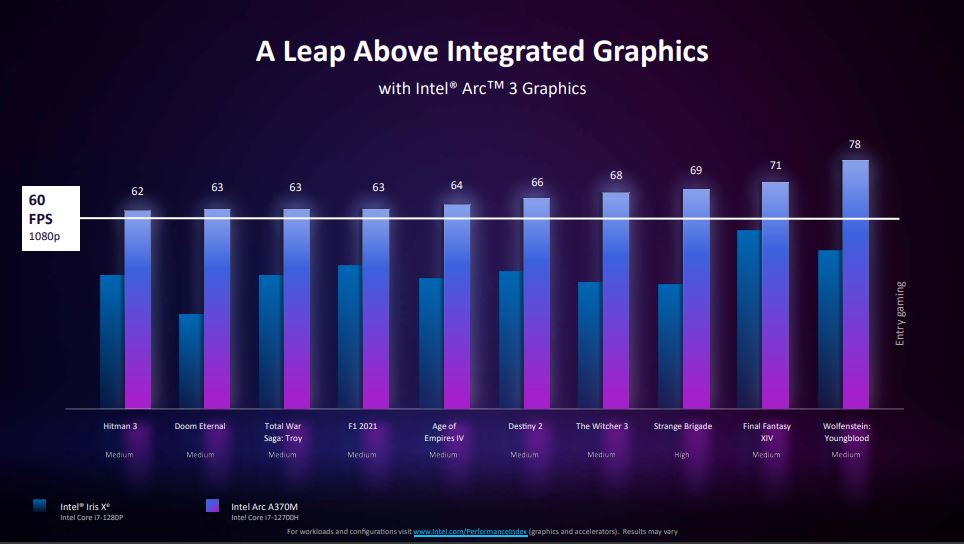Intel's first Arc laptop GPUs are available now: Here's what you need to know

The first Intel Arc laptop GPUs have hit the market, and more are due out later this year with support for gaming graphics tech like DirectX 12 Ultimate, hardware-based raytracing and Intel's new XeSS AI-powered supersampling.
This is a big deal because the graphics card market is hotter than I've ever seen it, so the fact that Intel will take on AMD and Nvidia with its new Arc GPUs this year could bring some much-needed competition (and GPU supply) to the industry.
Of course, we still have a while to wait before we see the first Intel Arc graphics cards for desktop PCs. Right now only the mobile Arc GPUs are available, as you can now order one of Samsung's new Galaxy Book2 Pro laptops configured with an Arc 3 GPU. That's the entry-level Arc mobile GPU, but if you want more power there will be beefier Arc 5 and Arc 7 GPUs available in laptops from partners like Acer, Asus, Dell, HP and more (pictured above) later this year.
As of now there are two Arc 3 GPUs available, the A350M and the more powerful A370M. Intel says the former is for laptops which prioritize lightness and thinness, while the latter is better for gaming performance.
These GPUs are officially branded the Intel Arc A-Series, and together they give us our first glimpse at what to expect from Intel's new discrete graphics cards. These GPUs support Intel's new Deep Link tech, which means they have special features that help them work especially well in tandem with Intel 21th Gen CPUs to deliver improved performance in compute-heavy applications like Adobe Photoshop, Handbrake and XSplit. Both GPUs ship with 4GB of DDR6 RAM, but the A350M has 6 Xe cores and 6 raytracing units while the A370M has 8 apiece.
These "Xe cores" are, on a very basic level, compute units optimized for gaming and content creation. Intel claims its Arc GPUs will excel in these areas because they're designed with features like Matrix Extensions (XMX) AI engines (which help drive Intel's new XeSS AI-powered supersampling tech) and an Xe media engine capable of hardware-accelerated AV1 (an open-source media codec) encoding, a feature no other GPU on the market can match.
Gaming on Intel Arc 3 laptop GPUs
Games should look pretty good on Intel's new Arc GPUS, as the company's new XeSS upscaling tech (which taps into the power of the GPU's Xe cores to algorithmically scale up the display resolution to, say 4K while maintaining performance you might expect at 1080p) appears good enough to rival similar technologies like Nvidia’s DLSS and AMD’s FidelityFX Super Resolution.
Get instant access to breaking news, the hottest reviews, great deals and helpful tips.
However Intel says XeSS won't actually be available until sometime this summer, and then only in select games, including an "exclusive integration" in Kojima Productions' Death Stranding Director's Cut that was teased at CES 2022. That's a bummer, but don't forget that XeSS is GPU-agnostic, meaning that while it's optimized to run best on Intel chips, it should also be available to folks on select Nvidia and AMD GPUs.
That means if you own an older Nvidia GPU that doesn't support Nvidia's own DLSS tech you may actually be able to coax better performance out of it by using XeSS in a supported game, a promise so sweet it's worth letting Intel take the time to get everything running just right.
Intel also claims it's working with game developers to ensure their games run well on Arc GPUs, and in its promo video for the new Arc 3 chips the company showed clips of games like Apex Legends, Destiny 2: The Witch Queen and Hitman 3 running on the A370M at over 60 frames per second.
Those are some decent framerates for a discrete laptop GPU that's supposedly on the low end of the Arc lineup. Of course, with XeSS still not operational and a wave of beefier Arc 5 and Arc 7 laptop GPUs due out this summer, not to mention the promise of Arc desktop GPUs waiting in the wings, all this really does is whet my appetite for what Intel is bringing to market later this year.
Outlook
With support for hardware-based raytracing, DirectX 12 Ultimate and its new XeSS upscaling tech, Intel's latest graphics cards look set to deliver some much-needed relief to the undersupplied GPU market.
We won't know for sure how the features and core counts of these new Arc 3 GPUs stack up against competing laptop GPUs from Nvidia and AMD until we test some Arc-powered laptops for ourselves, but based on what we know so far Intel appears to be bringing real heat to the GPU streets this year.

Alex Wawro is a lifelong tech and games enthusiast with more than a decade of experience covering both for outlets like Game Developer, Black Hat, and PC World magazine. A lifelong PC builder, he currently serves as a senior editor at Tom's Guide covering all things computing, from laptops and desktops to keyboards and mice.


